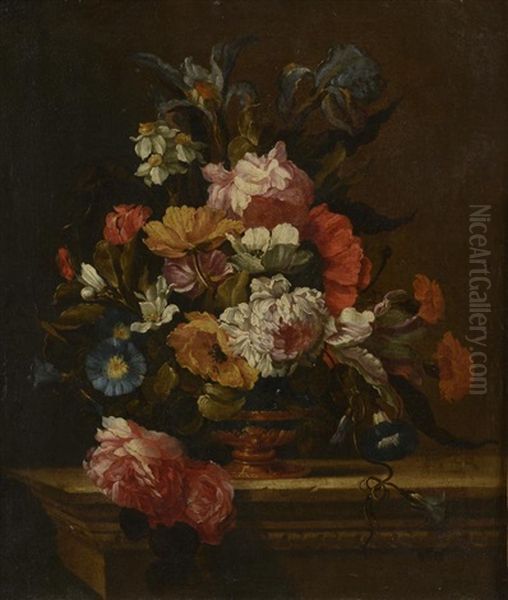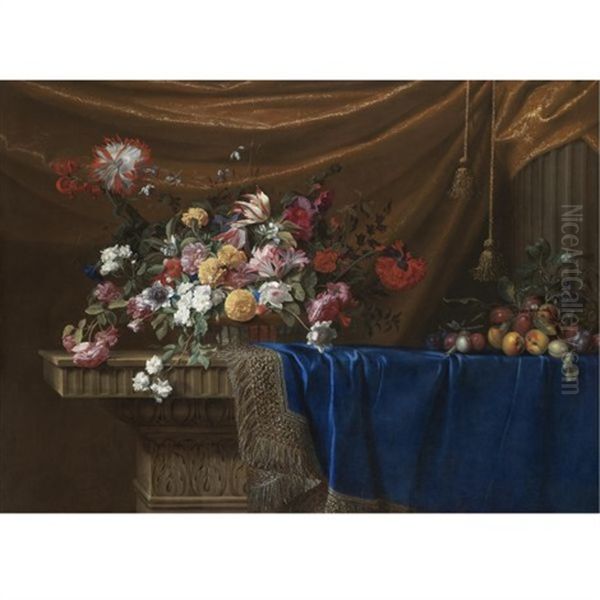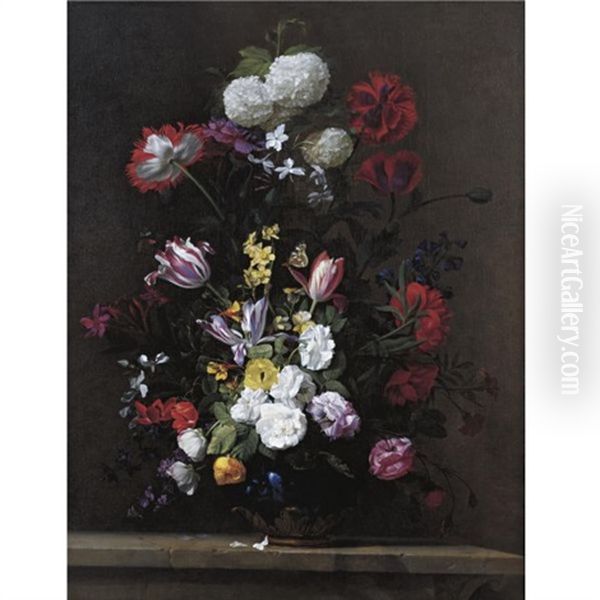Jean-Michel Picart (1600-1682) stands as a significant, if sometimes overlooked, figure in the rich tapestry of 17th-century European art. A painter of Flemish origin who carved out a distinguished career in Paris, Picart was celebrated for his exquisite flower and fruit still lifes. Beyond his own artistic output, he played a crucial role as an art dealer, bridging the artistic currents of Antwerp and the burgeoning art market of the French capital. His life and work offer a fascinating glimpse into the cross-cultural exchanges and evolving tastes that characterized this vibrant period in art history.
Early Life and Parisian Beginnings
Born in Antwerp around the year 1600, Jean-Michel Picart emerged from a city that was a powerhouse of artistic production, particularly renowned for its still life and genre painters. Antwerp, the home of masters like Peter Paul Rubens and Anthony van Dyck, fostered a rich environment for artists specializing in various genres. The Guild of Saint Luke in Antwerp was a dominant force, and the city's workshops produced art that was exported across Europe. It was within this milieu that Picart likely received his initial training, absorbing the meticulous techniques and penchant for detailed realism that characterized Flemish painting.
By the 1630s, Picart had made a pivotal move to Paris. The French capital was increasingly becoming a major cultural and artistic hub, attracting talent from across the continent. In Paris, Picart became a member of the Académie de Saint-Luc, the Parisian guild for painters and sculptors. This membership would have provided him with a professional network and the official sanction to practice his art and trade in the city. While detailed records of his specific activities and contributions within the Académie de Saint-Luc are scarce, his membership signifies his establishment within the Parisian artistic community.

An interesting, albeit minor, point of ambiguity surrounds his origins. While widely considered to be from Antwerp, some evidence suggests he might have been born in Paris and used a Frenchified version of a Flemish name. This could explain the lack of certain registration records in Paris under a purely Flemish name, but the prevailing scholarly consensus points to an Antwerp birth.
The Dual Role: Painter and Art Dealer
Jean-Michel Picart was not solely a creator of art; he was also an astute art dealer. This dual role was not uncommon in the 17th century, allowing artists to supplement their income and gain deeper insights into market demands and collector preferences. Picart's dealership activities were quite extensive. He is known to have traded in both original artworks and copies, catering to a diverse clientele.
His inventory included Dutch and Flemish landscape paintings, a genre highly popular for its evocative portrayal of nature and everyday life. He also dealt in hunting scenes, particularly those by or in the style of Frans Snyders, an Antwerp contemporary renowned for his dynamic and large-scale depictions of hunts and market scenes. Snyders, a collaborator of Rubens, excelled in capturing the vitality and raw energy of the animal world. Additionally, Picart handled smaller religious works, which continued to be in demand for private devotion.
A significant aspect of Picart's dealing business was his collaboration with Matthijs Musson, an influential art dealer based in Antwerp. This partnership was instrumental in bringing Flemish art to the Parisian market. Picart would order works from Musson, often specifying the types of subjects and styles that would appeal to French tastes. Musson, in turn, would commission Antwerp artists to produce these paintings. This transatlantic business relationship facilitated a flow of art and artistic ideas between the two cities, with Picart acting as a key intermediary and tastemaker in Paris.
Artistic Style: From Flemish Roots to Parisian Elegance
Jean-Michel Picart's artistic output primarily consisted of still life paintings, with a particular focus on floral arrangements and compositions of fruit. His style underwent a noticeable evolution throughout his career, reflecting both his Flemish heritage and his adaptation to the prevailing tastes in Paris.

His early works often exhibit a clarity and simplicity reminiscent of the pioneering Flemish still life painters like Osias Beert or Ambrosius Bosschaert the Elder. These artists, active in the early 17th century, were known for their carefully arranged, almost symmetrical compositions, where each flower or fruit was rendered with precise detail and individual attention. Picart's "Fruit still life with grapes and peaches" is an example that showcases this early approach, characterized by a meticulous rendering of textures and a balanced, harmonious arrangement. The influence of Jan van Kessel the Elder, another Antwerp painter known for his small, detailed studies of flowers, insects, and shells, is also discernible in Picart's early meticulousness. Van Kessel, a grandson of Jan Brueghel the Elder, continued the tradition of detailed naturalism.
As Picart's career progressed in Paris, his style gradually shifted towards a more decorative and opulent manner. This later phase saw his compositions become more elaborate, his bouquets fuller, and his use of color richer and more varied. This evolution aligned with the developing French taste for more sumptuous and overtly beautiful still lifes, a style that would be further popularized by artists like Jean-Baptiste Monnoyer. Indeed, Picart and Monnoyer are often cited together as two of the most successful still life painters in France during their time. Monnoyer, who also worked for the French court and later in England, became famous for his grand floral arrangements that adorned palaces and aristocratic homes.
Picart's paintings, such as his celebrated "Vase de fleurs sur un entablement" (Flowers in a Vase on an Entablature), exemplify this mature style. These works often feature a profusion of different flower species – tulips, roses, irises, carnations, and peonies – artfully arranged in ornate vases. He demonstrated a keen ability to capture the delicate textures of petals, the subtle play of light and shadow across surfaces, and the vibrant hues of each bloom. The compositions are often asymmetrical yet balanced, creating a sense of natural abundance and sophisticated elegance. He masterfully combined the detailed realism inherited from his Flemish training with a more fluid, decorative sensibility that appealed to his French patrons.
Themes and Symbolism in Picart's Still Lifes
Like many still life paintings of the 17th century, Picart's works were more than mere depictions of beautiful objects. They were often imbued with layers of symbolism, reflecting contemporary cultural, religious, and philosophical concerns. The tradition of flower painting, which blossomed in the Netherlands and Flanders, carried rich iconographic potential.

Flowers themselves could symbolize the transience of life and beauty (a vanitas theme), a reminder of mortality in an age acutely aware of it. The fleeting nature of a bloom, beautiful one day and withered the next, served as a poignant metaphor. Specific flowers also carried their own meanings: roses could symbolize love or, in a religious context, the Virgin Mary; lilies represented purity; and tulips, particularly prized and exotic at the time (leading to "Tulip Mania" in the Netherlands in the 1630s), could signify wealth, status, or the folly of speculation.
Fruit, too, held symbolic weight. Grapes might allude to the Eucharist or to Bacchus and earthly pleasures. Peaches could symbolize truth or salvation. The presence of insects, such as butterflies (resurrection, transformation) or flies (decay, brevity of life), further enriched the symbolic content. While Picart's primary aim was undoubtedly to create visually stunning compositions, the educated viewer of his time would have likely recognized and appreciated these underlying meanings. His works, therefore, operated on multiple levels, offering aesthetic delight, a display of technical virtuosity, and food for moral or philosophical reflection.
The careful depiction of luxurious items, such as ornate vases or imported fruits and flowers, also spoke to the prosperity of the era and the patrons who could afford such paintings. These works celebrated the beauty of the natural world, often enhanced by human artistry, and served as status symbols for their owners.
Picart and His Contemporaries
To fully appreciate Jean-Michel Picart's position, it's helpful to consider him in the context of his contemporaries. In Flanders, the still life tradition was incredibly strong. Jan Brueghel the Elder, known as "Velvet" Brueghel, was a foundational figure, creating intricate flower pieces and allegorical scenes. His son, Jan Brueghel the Younger, continued this tradition. Daniel Seghers, a Jesuit priest and student of Jan Brueghel the Elder, specialized in flower cartouches, often surrounding religious scenes painted by other artists like Cornelis Schut. Frans Snyders, as mentioned, dominated the field of large-scale animal and market still lifes, often collaborating with Rubens and Jacob Jordaens. Adriaen van Utrecht was another prominent Flemish still life painter known for his lavish banquet scenes and depictions of poultry and game.
In the Dutch Republic, still life painting also flourished, with distinct sub-genres. Willem Claesz. Heda and Pieter Claesz specialized in monochrome banquet pieces (ontbijtjes or breakfast pieces), characterized by subtle tonal harmonies. Jan Davidsz. de Heem became famous for his opulent and complex still lifes, filled with fruit, flowers, and luxurious objects, influencing painters in both the Netherlands and Antwerp. Willem Kalf was a master of the pronkstilleven (ostentatious still life), depicting precious glassware, Chinese porcelain, and exotic fruits with remarkable skill. Rachel Ruysch and Jan van Huysum, though slightly later, brought Dutch flower painting to a peak of delicate refinement.
In France, before the full impact of Flemish and Dutch styles, still life painting had a somewhat different character. Artists like Louise Moillon and Jacques Linard produced works that were often more restrained and formally arranged, though with a distinct charm and sensitivity. Picart, along with Jean-Baptiste Monnoyer, played a significant role in popularizing the richer, more decorative Flemish and Dutch approach to still life in France. His ability to blend Flemish meticulousness with a French sense of elegance made his work particularly appealing.
His role as a dealer also connected him to a wider network of artists whose works he traded. This would have kept him abreast of developments in landscape painting (perhaps works by artists like Jan van Goyen or Salomon van Ruysdael from the Netherlands, or Flemish landscapists like Joos de Momper or Paul Bril) and other genres.
Legacy and Enduring Appeal
Jean-Michel Picart died in Paris in 1682, at the advanced age of approximately 82. He left behind a body of work that testifies to his skill as a painter and his significant role in the Parisian art world of the 17th century. While perhaps not as universally recognized today as some of his Dutch contemporaries like de Heem or Kalf, or even his French peer Monnoyer, Picart's contribution was substantial.
His paintings are admired for their technical finesse, their vibrant yet harmonious color palettes, and their elegant compositions. They capture the 17th-century fascination with the natural world, the appreciation for beauty, and the underlying currents of symbolism that enriched art of this period. Works by Picart can be found in various museums and private collections, continuing to delight viewers with their timeless appeal.
His activities as an art dealer also highlight the interconnectedness of European art markets. By facilitating the movement of artworks and artistic styles between Antwerp and Paris, he contributed to the cross-pollination of ideas that enriched both traditions. He helped shape Parisian taste, introducing French collectors to the richness of Flemish and Dutch painting while adapting his own style to meet their preferences.
Unresolved Questions and Historical Nuances
Despite the information available, some aspects of Picart's life remain less documented. As previously mentioned, the precise details of his activities within the Parisian Académie de Saint-Luc are not extensively recorded. This is not unusual for many artists of the period, where guild records might be incomplete or focus more on administrative matters than individual artistic contributions.
The exact nature and extent of his personal workshop, including any assistants or pupils he might have had, are also not fully known. Given his success as both a painter and a dealer, it is plausible that he maintained a workshop to help meet demand, but specific names of followers directly trained by him are not prominent in art historical literature.
The stylistic similarities noted between Picart and artists like Jan van Kessel the Elder or Jean-Baptiste Monnoyer point to shared artistic currents and influences rather than direct master-pupil relationships in all cases. The 17th-century art world was one where artists keenly observed each other's work, borrowing motifs and techniques, and adapting them to their own purposes.
Conclusion: A Master of Floral Elegance
Jean-Michel Picart was a distinguished artist who successfully navigated the competitive art worlds of Antwerp and Paris. As a painter, he created still lifes of enduring beauty, evolving from a more traditional Flemish precision to a sophisticated Parisian elegance. His floral compositions, in particular, stand out for their vibrancy, detail, and decorative appeal, securing him a place among the notable still life specialists of his era.
Equally important was his role as an art dealer and cultural intermediary. His business dealings, especially his collaboration with Matthijs Musson, played a vital part in the dissemination of Flemish art in France and in shaping the tastes of Parisian collectors. Jean-Michel Picart thus represents a fascinating example of an artist whose career transcended geographical and artistic boundaries, leaving a legacy that reflects the rich and dynamic artistic exchanges of 17th-century Europe. His work continues to be appreciated for its aesthetic qualities and as a window into the cultural preoccupations of a bygone but brilliant age.